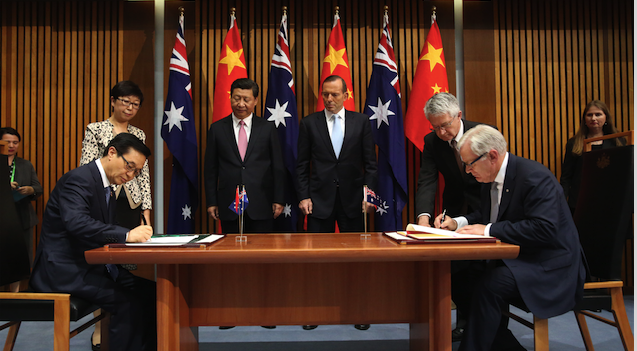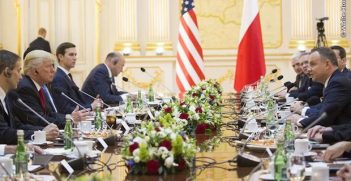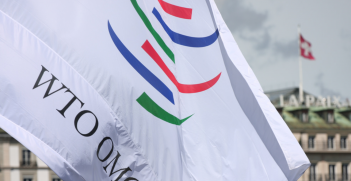Trade Agreements: More Strategic than Economic?

Australian trade policy is currently experiencing transformational change. Most notably, a trend for advancing Free Trade Agreements (FTA) has emerged. However, there is a concern that this trend is more focused on strategic than economic gains.
Over the last 30 years Australia’s key trade ties have transferred from Europe and the US to the Asia-Pacific. As a result, Australia has looked to secure trade agreements with these new economic partners.
Australia has now signed 10 FTAs—with New Zealand, Singapore, ASEAN, Thailand, Chile, Malaysia, South Korea, Japan, the US and China—while negotiations for a further seven are currently underway. The majority of these agreements entered into force within the last 15 years.
A common perception both within the public and media is that signing trade agreements, whether bilateral, regional or multilateral, offers mutually beneficial economic outcomes to all members. However, the economic benefits are not always clear.
Economic outcomes
For example, Australia is currently reviewing its position on the large multilateral Trans-Pacific Partnership (TPP), involving 12 Pacific Rim countries. However, a recent World Bank report found that Australia’s economy would only benefit 0.7% of GDP by 2030.
The Australia-US Free Trade Agreement (AUSFTA), which came into force over 10 years ago, also had questionable economic outcomes for Australia. With a large dataset now available, the body of evidence suggests that Australian and US trade actually fell during this period.
Shiro Armstrong reviewed the economic impact of the AUSFTA and stated: ‘Preferential trade agreements that are concluded, as the AUSFTA was, primarily for political reasons, can lead to suboptimal economic outcomes both from the point of view of member countries and of non-member countries.’
Business take up is also low. An Economist Intelligence Unit survey of 800 Australian businesses with revenues between $50 million and $1 billion found that only 19% of Australia’s exporters take advantage of FTAs.
In addition to this, concerned by a lack of economic benefits despite the growth of trade agreements, the Australian Productivity Commission recommended that the Australian government ‘should only pursue bilateral and regional trade agreements where they are likely to: afford significant net economic benefits; and be more cost-effective than other options for reducing trade and investment barriers, including alternative forms of bilateral and regional action.’
Strategic ties
Where there’s a noticeable lack of significant economic benefits flowing from a trade agreement, forging stronger political ties is almost always apparent. For instance, forging FTAs is heavily skewed toward strategic partners or allies.
In the US for instance, the Bush administration initiated a number of FTA negotiations with countries that were of strategic or geo-political importance to the United States. Agreements with Jordan, Morocco, Bahrain and Oman were primarily used to reward or shore up allies. In addition to this, the agreements with Australia, Chile and Singapore were aimed at increasing existing security ties.
It’s a similar story in Australia. Australia’s most recent trade agreements with Japan – our key Asian ally – and China – our largest trading partner – can be viewed as deepening both political and economic ties. As Ann Capling notes, Canberra’s motivations for a Japan FTA were more geo-political and strategic than economic or commercial. The FTA forms part of a recent trend to strengthen Australia-Japan relations, particularly around security and defence.
A key example of this is Japan’s role as a strong candidate to build Australia’s new submarine fleet. As Andrew Davies and Benjamin Schreer from the Australian Strategic Policy Institute have previously stated, selecting Japanese subs in what has been dubbed “Option J” offers a number of strategic advantages, notably a ‘deepening of the Australia–Japan defence relationship at a time of shifting major-power relations in the Asia–Pacific region’.
Balancing trade bouts
Part of Australia’s shift toward new bilateral trade agreements could also be viewed as a means to balance duelling trade agendas in regional multilateral trade agreements. Currently, the region has two competing trade agreements: the TPP and the Regional Comprehensive Economic Partnership (RCEP). The former was advanced by the United States and does not include China and the latter was advanced by China but does not include the US. Australia is negotiating in both agreements. However, its participation in both agreements is more about ‘balancing’ both China and the United States than pursuing economic gains. Similar economic bouts have also been played out in international banking and finance policy, where many analysts view China’s Asian Infrastructure Investment Bank (AIIB) – which Australia has joined, much to the ire of the US – as a counter institution to the US dominated World Bank.
Ultimately, it’s fair to consider strategic partnerships when negotiating Free Trade Agreements. Plus, FTAs do generally provide more positive economic outcomes than negative outcomes. However, FTAs should not be considered de facto security and geopolitical strengthening mechanisms. Overanalysing strategic considerations can lead to undermining economic considerations. Policymakers should not lose sight of the original purpose of trade agreements: tools for strengthening ties through economic means.
Heath Pickering is the editor of Election Watch 2016, a University of Melbourne project providing independent analysis of Australia’s upcoming federal election. He has previously worked on trade policy in the South Pacific and on a G20 project at the University of Melbourne. This article is published under a Creative Commons Licence. It may be republished with permission.





